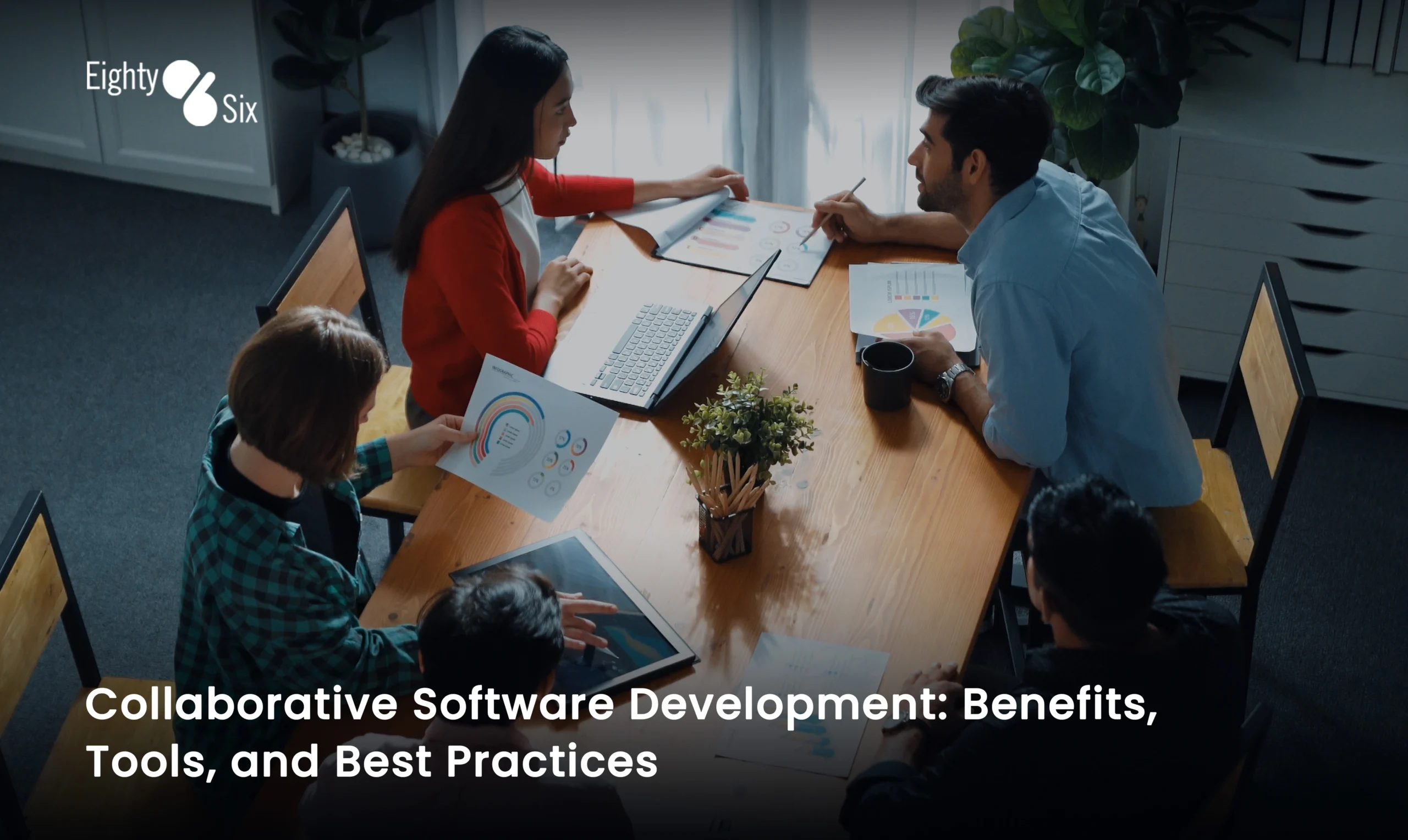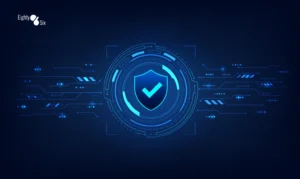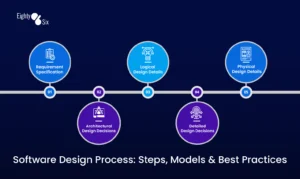Absolutely. Open ecosystems and shared tooling are accelerating safe AI development and validation, making collaboration even more vital.
Collaborative Software Development: Benefits, Tools, and Best Practices

Table of contents
Collaboration is the real “force multiplier” in modern engineering. It turns siloed contributors into a high-trust team that ships faster, catches defects earlier, and creates software that truly fits user needs. Whether you’re scaling an in-house product team or hiring software development services, building an intentional collaboration system—people, process, and platform—will decide your trajectory.
This guide is a practical playbook: the benefits you can bank on, the tool stack that actually helps, and field-tested practices to make collaboration reliable, not accidental.
Why Collaboration Wins: The Benefits You Can Measure
- Faster Cycle Times
- Small, frequent merges (instead of long-lived branches) shrink integration risk and keep momentum high. Trunk-based development, paired with feature flags, is explicitly designed for this cadence.
- Higher Code Quality
- Systematic code reviews and pair programming act as continuous knowledge transfer and early defect detection. Pairing provides immediate feedback; reviews add a second checkpoint—both together outperform either practice alone.
- Reduced Merge Hell & Fewer Rollbacks
- Working in small batches with solid CI reduces integration conflicts and makes rollback (or progressive delivery via flags) safer.
- Better Developer Experience & Retention
- Teams that collaborate well score higher across the SPACE framework dimensions (Satisfaction, Performance, Activity, Communication/Collaboration, Efficiency/Flow), which connect to sustainable productivity and morale.
- Resilience Through Shared Context
- Cross-reviewed code, ADRs (architecture decision records), and pairing reduce single-point-of-failure risk—vacations, attrition, or emergencies don’t create delivery.
- Clearer Product Fit
- Tight feedback loops between engineering, design, QA, DevOps, and stakeholders minimize rework and surface usability issues early.
The Collaboration Stack: Tools That Pull Their Weight
The right tools reduce friction; the wrong ones multiply it. Here’s a pragmatic stack that covers the software lifecycle end-to-end (choose equivalents if your org already has standards).
1) Source Control & Code Collaboration
- Git hosting: GitHub / GitLab / Bitbucket
- Branching model: Trunk-based development with short-lived branches; ship safely using feature flags.
- Code reviews: Mandatory pull requests; lightweight templates and checklists.
- Pairing/Mobbing support: Live share (VS Code), Tuple, JetBrains Code With Me; screen share fallback.
2) Continuous Integration & Delivery
- CI: GitHub Actions, GitLab CI, CircleCI, Jenkins
- CD: ArgoCD, Spinnaker, GitLab, GitHub Environments
- Testing layers: Unit → integration → end-to-end; run fast tests on every PR; full suites on main.
3) Work Management & Planning
- Backlog & boards: Jira, Linear, Azure Boards, ClickUp
- Roadmapping: Productboard, Jira Advanced Roadmaps, Notion
- Templates: Definition of Ready/Done, story mapping, impact mapping.
4) Communication & Knowledge
- Async: Slack, Teams; channels per product area + #incident + #release
- Docs: Confluence, Notion, Git-based docs; Architecture Decision Records (ADRs) pull the design intent closer to code.
- Runbooks: In repo or wiki; link from alerts.
5) Observability & Quality
- Monitoring: Prometheus, Grafana, Datadog, New Relic
- Logging: ELK/Opensearch, Loki
- Tracing: OpenTelemetry, Jaeger
- QA: TestRail, Playwright/Cypress dashboards
6) Security & Compliance
- SAST/DAST/Dependency scanning: Snyk, GitHub Advanced Security, SonarQube
- Secret scanning and policy as code (OPA) baked into CI.
Buying software development services? Ask vendors how their tooling enforces collaboration (PR gates, review rules, test coverage thresholds, observability SLOs). Tools reveal the truth of a team’s process.
Collaboration Patterns That Actually Work (Step-By-Step)
A. Trunk-Based Development (+ Feature Flags)
Goal: Ship small, ship often, keep main releasable.
How to run it
- Create short-lived branches off main for well-scoped tasks (ideally < 1–3 days of work).
- Protect main: required checks (CI green, code owners), linear history, small PR size limits.
- Use feature flags to merge incomplete work while keeping it dark; expose flags to QA and product for progressive rollout.
- Automate everything: build, test, security scans, preview environments.
- Release often (daily/weekly) to make deployments boring and reversible.
Anti-patterns to avoid
- Long-lived “release branches” that become stale and painful to merge.
- Massive PRs that are impossible to review well.
- Manual test gates that block flow and produce inconsistent results.
B. Code Reviews That Build Teams (Not Just Gatekeepers)
Policy
- Every PR gets at least one qualified reviewer (code owners).
- SLAs: small PRs reviewed within business hours same day; larger ones within 24 hours.
- Use templates: purpose, scope, risks, testing evidence, screenshots.
Technique
- Review for design correctness first, then style.
- Discuss in comments; if diverging, jump to a 10-minute call to converge.
- Track review metrics as part of SPACE “Communication/Collaboration”: review time, comment depth, merge velocity.
C. Pair Programming & Mobbing (Use Selectively)
When to pair
- Complex, risky code paths; onboarding; gnarly bugs; architecture spikes.
Roles
- Driver (at the keyboard) and Navigator (thinks ahead, reviews in real time). Rotate frequently.
Benefits
- Instant feedback, shared context, fewer defects; complements (doesn’t replace) formal reviews.
How to make it stick
- Scheduled “pairing blocks” on the team calendar; use Live Share/Tuple.
- Keep sessions short (60–90 minutes) with breaks; set a clear objective for each session.
D. Design Collaboration (Engineers × Product × Design)
- Run discovery with structured artefacts: problem statements, JTBD, hypotheses.
- Create design docs (2–5 pages) for significant changes; include alternatives and trade-offs.
- Record decisions as ADRs in the repo; link ADR IDs in PR descriptions.
E. QA as a First-Class Partner
- Shift left: QA writes test charters and helps define acceptance criteria during refinement.
- Pair QA with developers on automating the “happy path” and most critical regressions.
- Use test data contracts and synthetic data packs for reliable, repeatable tests.
F. DevOps & Platform Collaboration
- Standardize golden paths (starter templates, CI pipelines, observability), published as internal packages/blueprints.
- Treat infrastructure as code (Terraform, Helm) and include platform engineers as code owners for infra directories.
G. Documentation That People Actually Read
- Keep docs close to code (docs/ folder) and auto-publish to a docs site.
- Prefer living specs (OpenAPI, AsyncAPI) and executable examples over prose.
- Make “docs or it didn’t happen” part of your Definition of Done.
Setting Targets: How to Measure Collaboration (The SPACE Way)
Old-school metrics (commits/day, lines of code) don’t reflect real productivity. Use a balanced set aligned with the SPACE framework:
- Satisfaction & Well-being: quarterly pulse scores, on-call load, PTO usage.
- Performance: DORA metrics (lead time, deployment frequency, MTTR, change failure rate).
- Activity: PR throughput, review turnaround.
- Communication & Collaboration: % PRs reviewed on time, pair-programming hours, cross-team PRs.
- Efficiency & Flow: time in review, WIP age, build time, flaky test rate.
A Practical Collaboration Workflow (Week-to-Week)
Weekly cadence (sample):
- Mon: 45-min planning. Capacity check, select work, slice into 1–3 day tasks.
- Daily: Async stand-up in Slack thread + 10-min live sync if needed.
- Tue/Thu: 90-min pairing blocks for risky items.
- Wed: Architecture review (45 min) to unlock future epics; decisions → ADRs.
- Fri: Demo (show working software), retro (what to start/stop/continue). Retro actions go into the backlog with owners.
Pull request lifecycle (happy path):
- Ticket moved to In Dev, branch created from main (short scope).
- Draft PR opened early (CI runs; preview env spins).
- Self-review checklist done; request review from code owners.
- Fast tests pass; reviewer approves within SLA; feature behind a flag.
- Merge: CD promotes to staging; observability checks.
- Progressive rollout (flag on 1%, 10%, 50%, 100%); monitor error budgets.
Collaboration Anti-Patterns (How to Spot and Fix Them)
- Monster PRs: Anything > 500–700 LOC net changes usually hides multiple concerns. Split by behavior or layer.
- Review ping-pong: Too many back-and-forth comments? Jump to a quick call, then summarize the decision in the PR.
- “It works on my machine”: Use containerized dev envs and pre-commit hooks to standardize.
- Invisible design: Decisions buried in Slack; fix by mandating ADRs.
- Flaky tests: Track and burn down; gate merges on a stability score.
- Long-lived feature branches: Move to flags and smaller slices. Trunk-based techniques exist precisely to prevent this.
Tooling Guide: Choosing the Right Collaboration Tools (Buyer’s POV)
When evaluating collaboration tooling (or a partner’s stack for software development services), prioritize:
- Integration Across the Lifecycle
- Planning ↔ code ↔ CI/CD ↔ monitoring. Look for first-class integrations and API/webhooks to automate handoffs. Guides from Planview and practitioners emphasize end-to-end support.
- Support for Real-Time & Async
- Remote teams need both: chat, huddles, and threaded async updates. 2025 tool roundups highlight Slack/Teams as the baseline for distributed collaboration.
- Policy Enforcement
- Protected branches, required reviews, status checks, secret scanning, dependency updates. These features encode collaboration into the flow.
- Developer Ergonomics
- Fast CI, ephemeral preview environments, pre-configured dev containers, IDE collaboration. Lower friction = more collaboration by default.
- Observability by Design
- Standard logging, metrics, tracing; dashboards per service; SLOs visible to devs (not just ops).
- Security in the Loop
- SAST/DAST, supply-chain protections, SBOM generation, and policy gates in CI.
Collaboration Scenarios & Mini-Playbooks
1) New Team, New Codebase
- Start with a paved path: repo template (CI, codeowners, linting, test harness, PR template).
- Trunk-based from day one; small PR rule; feature flags for risky work.
- Agree on the communication contract: what’s async vs meeting vs doc.
2) Legacy App Under Active Development
- Introduce a strangler pattern: wrap with a stable API, build new components alongside.
- Raise the floor: add a smoke-test suite and pre-commit checks; require reviews on high-churn directories first.
- Incrementally move to small PRs and a weekly release train with canaries.
3) Distributed Organization
- Over-invest in documentation and async rituals (written design docs, decision logs).
- Use “follow-the-sun” handoffs with checklists to maintain continuity.
- Bias toward fewer, clearer tools; map channels to product areas.
4) Security-Sensitive or Regulated Domains
- Threat-model with product/design in discovery.
- Enforce 4-eyes on sensitive code, signed commits, and change approvals.
- Keep audit trails (PR discussions, ADRs, CI logs) for compliance.
5) Open Source & InnerSource
- Public design docs/issues, newcomer-friendly labels, and contribution guides.
- Maintain a “good first issue” pipeline and a mentorship pairing program.
- Treat internal teams as external contributors to drive quality.
Tip: If you’re purchasing software development services, ask vendors for sample PRs, ADRs, and pipeline definitions. Their artifacts will show you how they collaborate—no slide deck needed.
Advanced Topics: Where Collaboration Is Evolving
- Local-first & CRDT-based collaboration is reshaping how teams co-edit with privacy and offline resilience—useful for edge or regulated contexts.
- Responsible Open Collaboration in AI: Open models and shared tooling are accelerating safe, verifiable development across orgs. If your product touches AI, plug into these communities to avoid reinventing the wheel.
Checklists & Templates (Copy/Paste)
PR Template (short version):
- Why: Problem, user impact, success metric
- What: Scope, approach, flags/toggles
- How tested: Unit, integration, screenshots/logs
- Risks & rollback: Known risks, revert plan
- Docs: ADR link, docs updated?
- Owners: Reviewers tagged
Definition of Ready (DoR):
- Problem statement, acceptance criteria, non-goals
- Dependencies clarified, test data needs identified
- Slice fits in 1–3 dev days
Definition of Done (DoD):
- CI green, tests updated, docs/ADRs updated
- Observability hooks added (logs/metrics/traces)
- Feature behind a flag (if partial)
- PR reviewed/approved, changelog entry added
Common Questions from Leaders Buying Software Development Services
- How do you enforce collaboration quality?
- Show protected branch rules, PR metrics, review SLAs, CI checks, and DORA/SPACE dashboards.
- How do you transfer knowledge?
- Pairing during onboarding, ADRs, brown bags, rotating ownership.
- How do you ensure speed without breaking things?
- Trunk-based + flags + test automation + staged rollout + observability.
Conclusion: Make Collaboration Your Competitive Advantage
Collaboration isn’t a vibe; it’s a system. When you combine trunk-based development, disciplined reviews, selective pairing, strong CI/CD, and a documentation culture, you create a flywheel: faster learning → fewer defects → happier engineers → faster delivery → happier users.
If you’re comparing software development services, choose a partner that shows these habits in their artifacts and pipelines—not just in proposals.
At 86 Agency, we treat collaboration as a product in itself. Our engineers work in trunk-based flows with robust CI, code owners, and feature-flagged rollouts. We co-create with your product and design teams, make every decision traceable via ADRs, and measure progress the modern way (DORA + SPACE). If you’re ready to build a sustainable delivery engine—not just ship a release—contact us. We’ll bring the playbooks, tooling, and people to elevate your team and outcomes.
FAQs: Collaborative Software Development
1) Is pair programming worth the cost?
Yes—used selectively. It’s ideal for complex work, onboarding, and critical areas. Pairing provides immediate feedback and knowledge transfer, while code reviews still provide the formal gate. Use both for best results.
2) Do we need trunk-based development to collaborate well?
It’s not the only way, but it’s the most proven for reducing integration pain and improving release cadence. Combine it with feature flags and strong automated tests.
3) Which tools are “must-have” for a small team?
Git hosting with PRs, CI that runs tests on every PR, a shared backlog/board, and a docs space tied to the repo. Add observability and flags as you grow. Modern tool roundups consistently place Slack/Teams and Git-based platforms at the core.
4) How do we measure collaboration without gaming the system?
Use a balanced SPACE approach, plus outcome metrics like DORA. Avoid vanity counts (commits/LOC). Track review times, knowledge sharing, and flow efficiency.
5) We’re distributed—how do we keep everyone aligned?
Write more: short design docs, ADRs, weekly summaries. Use async status threads and a strict channel taxonomy. Time-box meetings; record decisions in the PR or ADR.
6) How do feature flags interact with QA?
Flags let QA validate in staging or production safely. Create a clear flag taxonomy (release/ops/experiment), ownership, and sunset policy to avoid “flag debt.”
7) What if our codebase is legacy and fragile?
Start with smoke tests, protect high-risk areas with code owners, slice changes into tiny PRs, and ship behind flags. Move toward a weekly release train and canary deployments while you pay down the highest-ROI tech debt each sprint.



